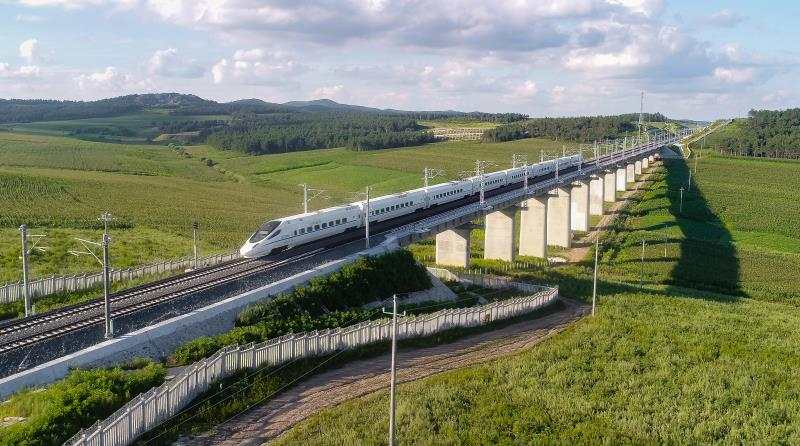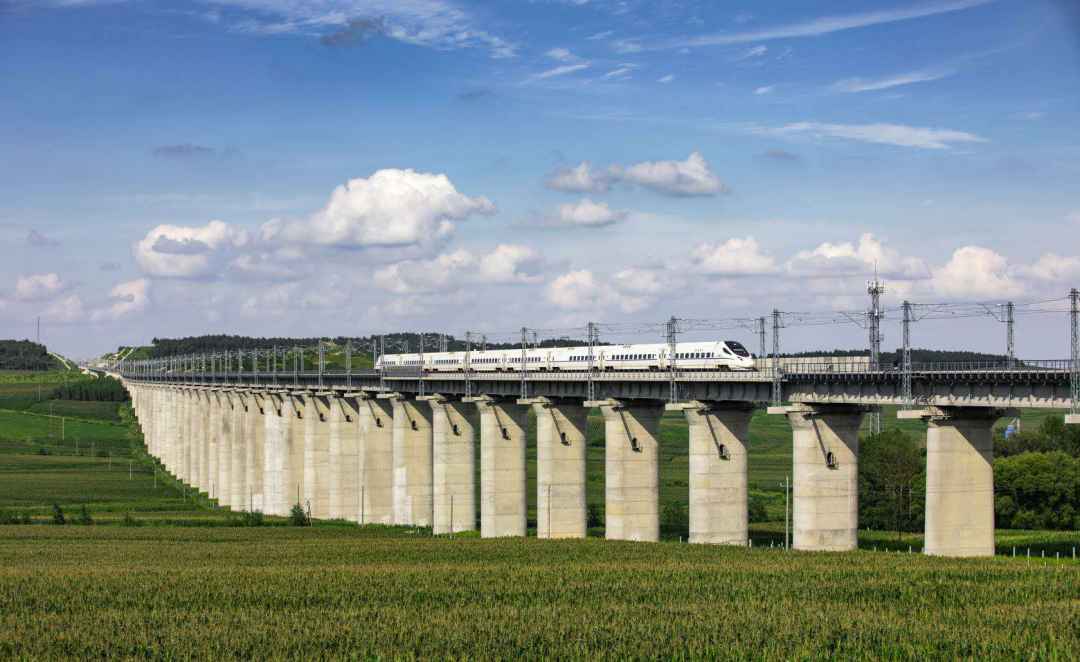
China boasts plentiful experience in alpine railway construction and operation. In 2006, Qinghai Tibet Railway, reputed as “the sky road”was put into operation; in 2012, the first alpine railway-Harbin Dalian Railway at the designed speed of 350km per hour started operation; at 6:36 a.m. on July 16 this year, as the train going through 55001 operational tests pulled out of Harbin West Railway Station, the longest high-speed railway in alpine terrains of China, Harbin-Jiamusi Railway was officially in trial operation.
So here comes this question. How can China trains speed through geologically complex alpine terrains which are susceptible to blizzards and -40℃ temperature environment? What technical roadblocks need to be conquered?
Difficulties: Roadbed frost heaving and overhead line anti-icing
Frost heaving constitutes the cardinal technical bottleneck in alpine railway construction, remarked by Li Xiongfei, the chief engineer and deputy general manager of Harbin-Jiamusi passenger railway company.
Taking Qinghai-Tibet Railway as an example, frozen soil will freeze like ice in winter and as temperature drops, its volume will swell. And roadbed and steel rails will be jacked up by swollen frozen soil. In summer, temperature rises, frozen soil thaws and shrinks. Roadbeds and steel rails will subside. Freezing and thawing recur and rotate. Roadbeds will be subject to frost heaving, mudding, deposition and deformation and steel rails will lie in undulation. If trains speed through this kind of terrains, the body of trains will jolt and jeopardize traffic safety.
Compared with ordinary alpine railway, alpine high-speed trains encounter more daunting challenges. High speed trains put greater pressure on roadbed and rails with more pronounced threats induced by frost heaving. Furthermore, heavy snow will also wreak havoc on trackside equipment like overhead lines or transponders. When accumulated snow in railways is blown by D-series high-speed trains, frozen ice will form between the underbody and body and gradually enlarge. When trains move to zones with relatively higher temperature or pass through tunnels at high speeds, ices carried by the underbody and body will massively fall off and into the middle and both sides of the railway, directly hit the signal equipment, do damage to the equipment, and disrupt the smooth operation of trains.

Spectacular scenery along Harbin-Jiamusi Raiway Photo from the Internet
Technicians in China tackled these difficulties.
In terms of Harbin-Dalian Railway, technical personnel have exerted efforts to devise specific overhead line de-icing and anti-icing technologies, and designed online contact system of the overhead line icing.
To address frost heaving issue, technical personnel installed insulated cold-proof equipment in tunnel sewages, and enforced stringent regulations over the category, scale, and grain size of roadbed stones. They also set up hundreds of frost heaving surveillance facilities along the railway lines intended for monitoring the changing conditions of roadbed.
According to Li Xiongfei, when the height of roadbed frost heaving reaches 8mm, it denotes that the conditions are pretty grave. All laid steel rails should be dismantled and replaced. If the height is only below 8mm, only daily maintenance is required.
Meteorological services penetrate the whole process of alpine railway
Actually, for alpine railway, all meteorological and environmental factors should be taken into account throughout the whole span of design, construction, and operation.
Harbin-Dailian Railway did not adequately apply the advanced alpine railway construction technology due to the lack of in-depth design. During the debugging and commissioning process, frost heaving surfaced. In addition, prevention and protection facilities were not installed in the trackside equipment of transponders. Transponders and related pedestals bear the brunt of ice and snow. When problems are detected, remedial measures were taken, which provided cautions for future alpine railway construction.

Spectacular scenery along Harbin-Jiamusi Raiway Photo from the Internet
During the construction, extreme weather is a test. According to Li Long, a worker who took part in the construction of Harbin-Jiamusi Raiway, in line with historical meteorological data, Northeast railway construction units define the period from November 15 to March 15 as “winter hiatus period”, in a bid to adjust construction plan. Affected by winter low temperature and summer heavy precipitation, the actual construction time span of Harbin-Jiamusi Railwayin in the whole year only lasted 8 months. Concrete mixing only took place outside of the tunnel. According to the weather forecast on electronic display screen, once temperature drops and snow falls, workers will lay thick quilts on mixing vehicles for fear of freezing the machines. Temperature during welding should be kept from 18℃to 19℃. During summer, construction is executed at night in a bid to complete welding before winter. Sometimes barely did workers concocte concretes when a sudden wave of heavy rain befell and changed the scale of concretes, which would affect construction quality afterwards.
During the operation, China has also accumulated experience in the meterological support for alpine railway. Jilin provincial meteorological service center has designed refined ice and snow forecasting products for Harbin Dailian High-speed Railway. High-speed Railway operational departments timely activated ice and snow early warning in accordance with ice and snow forecast and monitoring, and safeguarded the secure operation of high-speed railway.
Bringing wellfare to the world
Although places across the globe has undertaken railway construction for over one hundred years, alpine railway construction remained a hard nut to crack. Eurostar once encountered frozen accident when traversing the tunnel of the English Channel. The maximum deposition of the railway lowered to 85 cm after spring thawing and rendered the railway that Russia constructed in frozen earth areas of Siberia not passable.

Spectacular scenery along Harbin-Jiamusi Raiway Photo from the Internet
Most alpine railways are ordinary lines and high-speed railways are quite rare. So far, except China, there are only 3 alpine high-speed railways which are placed into commercial operation. But these 3 lines are renovated on the basis of existing railways, not alpine railways in the strict sense.
When China constrcuted alpine railway, there was no experience to resort to and no technology to be introduced.
In the 1970s and 1980s, cold regions, small-radius curves, bridges, and seamless railway construction in mountainous regions are four out-of-bounds fields in railway construction of China. After over 30 years of studies and practice, high-speed trains in China can operate against the backdrop of -40℃ to 40℃ environment. When trains instantaneously enter hygrothermal environment from freezing environment, they evade condensed water trap. No matter how cold it is outside the compartment, indoors temperature is comfy in cold-proof trains. China has established a complete alpine railway technology system.
The construction of Harbin-Jiamusi High-speed Railway demonstrates that China has mastered the technology of railway construction in alpine regions. Railway cooperation represented by the railway “going global” not only builds advanced and convenient transportation, but also brings welfare to regions across the globe.
In the midst of 2014, Mr Dmitry Medvedev, Prime Minister of Russia visited the exhibitions of Moscow International Forum for Innovative Development “Open Innovations”and inquired about whether the new generation high speed railway trains could operate in alpine regions. And now, China has delivered satisfactory results.
Author: Liu Shuqiao, Lai Xuwen Sun Nan